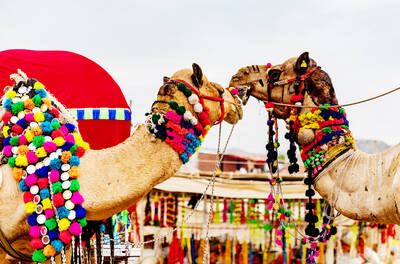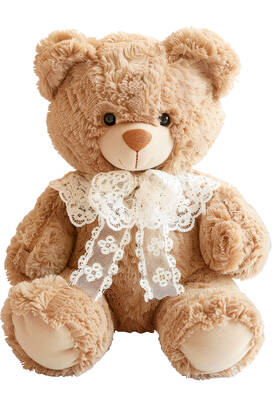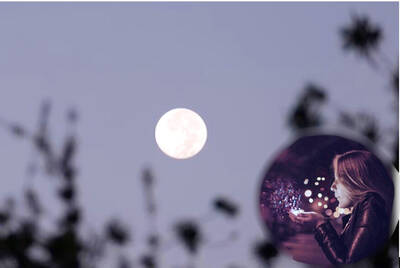Rice is an essential ingredient in Taiwanese cuisine. Many foods are made of rice, adding more variety to our cooking, such as rice cake, or “gui.” Wagui is made by steaming rice flour batter in a bowl. The term “gui” refers to a type of food made from rice, while “wa” refers to a bowl. The pronunciation of “gui” in Taiwanese Hokkien is similar to the word for “nobility” in Chinese, so it is common for people to prepare various types of gui, including wagui, as offerings to the gods or ancestors,.
米是台灣重要的主食,用米製成的食品十分多元,豐富我們的飲食,如米做成的「粿」。粿的意思是米做成的糕點,碗粿是將在來米漿倒入碗中蒸熟,因而得名。粿因為音同「貴」,因此碗粿等粿食常用作供品祭拜神明和祖先。
nobility (n.) 高貴,高尚;貴族

Photo: Bookman l 圖片:書林
offering (n.) 供品
While Taiwan may not be a large island, there are still many types of wagui based on the ingredients they use. For example, a sweet version of wagui is a Hakka people’s snack made by adding dark brown sugar to the rice flour batter. Furthermore, in northern Taiwan, another Hakka style wagui which has a savory taste is commonly found in traditional markets. Its rice flour batter is steamed without any seasoning, resulting in a smooth and white appearance. The Hakka wagui is often topped with minced pork and dried pickled daikon and drizzled with soy sauce, giving it a simple yet satisfying taste by allowing the rice flavor to shine through.
台灣雖不大,但碗粿的滋味卻是十分豐富,像是在米漿中加入黑糖的客家甜碗粿,還有常在北部菜市場看到的客家鹹碗粿,其米漿不經調味料即蒸熟,外觀白色平滑。鋪上絞肉、菜脯等配料,並淋上醬油,滋味樸實卻能突顯米的清香。
seasoning (n.) 調味料,佐料
shine through (v. phr.) 顯露
Compared to the light flavor of the Hakka version, Tainan’s wagui is known for its many ingredients and stronger flavor. The rice flour batter is steamed with cooked ingredients like sliced soy eggs, velvet shrimp, shiitake mushrooms and braised minced pork. This rice cake has a richer taste and darker appearance that is often referred to as “black wagui,” while the Hakka version is referred to as “white wagui.” After being steamed, a sweet thick soy sauce is put on top of black wagui to enhance the flavor. Locals in Tainan typically pair wagui with floating milkfish in thick soup, while migao is commonly served with fish ball soup. This custom has been passed down through generations and is still followed by many today.
和清爽的客家碗粿相比,台南碗粿特色是豐富配料,粉漿中會加入切片滷蛋、火燒蝦、香菇、肉燥一起蒸熟,讓粿本身也帶有鹹味,粿的外觀呈褐色,因而有「黑碗粿」之稱,北部的則稱為「白碗粿」。蒸好之後然後淋上甜的醬油膏,台南人吃碗粿時還會點浮水魚羹,吃米糕則搭配魚丸湯,這是自古流傳下來的習慣。
To make wagui, start by stirring a mixture of rice flour and hot water until it thickens. Then, pour the batter into bowls, which give wagui its bowl-like shape, and steam it. Since freshly-steamed wagui doesn’t have the best texture, wagui has traditionally been left to cool overnight after steaming, which results in the tender and chewy texture that many people prefer.
碗粿要怎麼做呢?先將在來米粉和水攪拌至濃稠後,倒入碗中蒸熟,因此碗粿造型才像是碗一樣。但剛蒸好卻不是最美味的,以前的碗粿是前一天晚上蒸好,冷卻後隔天再拿來吃,才會是大家愛吃的軟Q碗粿。
mixture (n.) 混合物
thicken (v.) 變厚,變密,變濃
文章由書林出版公司提供:
www.bookman.com.tw

★ Bilingual Story is a fictionalized account. 雙語故事部分內容純屬虛構。 Kevin leaned over the bubbling pot. “Hey. . . are you okay? You’ve barely touched your food.” Zoey blinked. Her face was red — not from blushing, but from the “mala” spice and the heat of the room. Her blond hair clumped to her face like strands of fine spaghetti. Her carefully applied makeup now streaked. “This isn’t what I expected,” she said softly, forcing a smile. All around them, Kevin’s friends were laughing, shouting, and tossing ingredients into the broth. The air smelled of chili oil and garlic.

Picture this: contestants are walking gracefully across a stage, competing for the highly desired title of “most beautiful.” However, these participants aren’t fashion models—they’re camels. Welcome to the extraordinary world of the Pushkar Fair, where beauty contests take on an entirely different meaning. The Pushkar Fair is held annually in the small desert town of Pushkar, India, usually in November. It began as a livestock trading event where farmers and herders gathered to buy and sell camels, horses and cattle. Over time, it has grown into a major cultural carnival that attracts thousands of tourists from around the world.

Continued from yesterday(延續自昨日) https://www.taipeitimes.com/News/lang If plushie charms are cute little nods to people’s interests, ita bags are full-on declarations. The term “ita” comes from the Japanese word itai, which means “painful” and reflects the overwhelming visual intensity of these bags. An ita bag is essentially a handbag, backpack, or tote meticulously decorated with an extensive collection of merchandise dedicated to a specific character or idol. These bags usually feature a clear plastic window to display carefully arranged pins, badges, keychains, or fan art. Both the interior and exterior may be covered in fandom memorabilia, creating an aesthetic so intense that it’s almost “painful”

對話 Dialogue 清清:華華,你知道嗎?聽說11月5號有「超級月亮」!那天的月亮會特別大、特別亮。 Qīngqing: Huáhua, nǐ zhīdào ma? Tīngshuō shíyī yuè wǔ hào yǒu “chāojí yuèliàng”! Nà tiān de yuèliàng huì tèbié dà, tèbié liàng. 華華:真的嗎?太棒了!我想去河邊看月亮,順便拍照片。 Huáhua: Zhēnde ma? Tài bàng le! Wǒ xiǎng qù hébiān kàn yuèliàng, shùnbiàn pāi zhàopiàn. 清清:聽說在超級月亮出現的那天晚上許願,願望比較容易實現。 Qīngqing: Tīngshuō zài chāojí yuèliàng chūxiàn de nàtiān wǎnshàng xǔyuàn, yuànwàng bǐjiào róngyì shíxiàn. 華華:是嗎?讓我好好想想要許什麼願。 Huáhua: Shì ma? Ràng wǒ hǎohǎo xiǎngxiǎng yào xǔ shénme yuàn. 清清:哈哈,我已經想好了,我希望「每天都準時下班」。 Qīngqing: Hāhā, wǒ yǐjīng xiǎng hǎo le, wǒ xīwàng “měitiān dōu zhǔnshí xiàbān”. 華華:嗯......我希望今年「年終獎金加倍」 Huáhua: ēn... wǒ xīwàng jīnnián “niánzhōng jiǎngjīn jiābèi”! 清清:等你把手邊的專案做完,你的願望一定可以實現的。 Qīngqing: Děng nǐ bǎ shǒubiān de zhuān’àn zuò wán, nǐ de yuànwàng yídìng kěyǐ shíxiàn de. 華華:希望一切能順利! Huáhua: Xīwàng yíqiè néng shùnlì! 翻譯